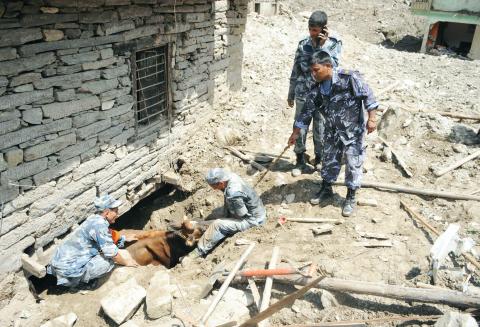There is no chance of finding any of the more than 150 people who are believed to have been buried by a massive landslide in northern Nepal, an official said yesterday, as rescuers struggled to dig through piles of rock, mud and trees.
Rescuers have so far recovered only eight bodies since the landslide early on Saturday blocked a mountain river, causing the water to form a lake that was threatening to burst and sweep several villages.
Fresh rainfall yesterday hampered search attempts.

Photo: AFP
“We have no chance of finding any of the missing people alive under this pile of debris,” said Yadav Prasad Koirala, who heads the government’s Department of Natural Disaster Management. “We have names of 159 people who are believed to be missing and buried, but there could be even more people.”
Koirala said it was even difficult for bulldozers and heavy equipment to move the debris that crushed dozens of houses in the village of Mankha, about 120km east of Kathmandu.
Gopal Parajuli, the chief government administrator in the area, said the water level and mud was making the rescue work very difficult, and that army troops used explosives to try to alleviate a dangerous buildup of water.
Controlled explosions by the army were able to knock down part of the earth wall that had blocked a river and created a temporary dam, allowing some water to flow out, but much of it still remained trapped, posing an immediate threat to downstream villages as far as India.
Parajuli said the amount of water flowing out of the dam and pouring in was almost the same yesterday, keeping the water level stable.
A man who was among the dozens of people injured by the landslide said the death toll could be higher than 100.
“There are nearly 100 people in the 60 houses in my village and 20 more people in the neighboring village who were buried by the landslide. All of them are likely dead,” Durga Lal Shrestha said from his hospital bed in Kathmandu, the capital, where he was flown by helicopter.
Shrestha, who suffered bruises on his face and arms, said he and his family heard a rumbling sound and the ground shook like an earthquake.
“The walls in my house caved in, but the roof was fine and that is how we were able to survive,” he said. “When we came out, it was dark and muddy. Everyone was screaming and it was a chaotic situation.”
About 40 people were injured. Besides Shrestha, 10 others were flown to Katmandu for hospital treatment, including a Belgian man.
The Arniko highway, which connects Nepal to Tibet, remained closed yesterday.
In neighboring India’s Bihar, authorities evacuated thousands of villagers after flood warnings were issued in eight districts at risk of flash floods from Nepal.
The evacuations began on Saturday and continued through yesterday, said Anirudh Prasad, a top official in Patna, Bihar’s capital. Indian army soldiers and air force helicopters and jets were being readied to launch relief and rescue operations, he said.
Landslides are common in mostly mountainous Nepal during the rainy season, which runs from June through next month.

Airlines in Australia, Hong Kong, India, Malaysia and Singapore yesterday canceled flights to and from the Indonesian island of Bali, after a nearby volcano catapulted an ash tower into the sky. Australia’s Jetstar, Qantas and Virgin Australia all grounded flights after Mount Lewotobi Laki-Laki on Flores island spewed a 9km tower a day earlier. Malaysia Airlines, AirAsia, India’s IndiGo and Singapore’s Scoot also listed flights as canceled. “Volcanic ash poses a significant threat to safe operations of the aircraft in the vicinity of volcanic clouds,” AirAsia said as it announced several cancelations. Multiple eruptions from the 1,703m twin-peaked volcano in

Chinese President Xi Jinping (習近平) launched a week-long diplomatic blitz of South America on Thursday by inaugurating a massive deep-water port in Peru, a US$1.3 billion investment by Beijing as it seeks to expand trade and influence on the continent. With China’s demand for agricultural goods and metals from Latin America growing, Xi will participate in the APEC summit in Lima then head to the Group of 20 summit in Rio de Janeiro next week, where he will also make a state visit to Brazil. Xi and Peruvian President Dina Boluarte participated on Thursday by video link in the opening

China has built a land-based prototype nuclear reactor for a large surface warship, in the clearest sign yet Beijing is advancing toward producing the nation’s first nuclear-powered aircraft carrier, according to a new analysis of satellite imagery and Chinese government documents provided to The Associated Press. There have long been rumors that China is planning to build a nuclear-powered aircraft carrier, but the research by the Middlebury Institute of International Studies in California is the first to confirm it is working on a nuclear-powered propulsion system for a carrier-sized surface warship. Why is China’s pursuit of nuclear-powered carriers significant? China’s navy is already

IT’S A DEAL? Including the phrase ‘overlapping claims’ in a Chinese-Indonesian joint statement over the weekend puts Jakarta’s national interests at risk, critics say Indonesia yesterday said it does not recognize China’s claims over the South China Sea, despite signing a maritime development deal with Beijing, as some analysts warned the pact risked compromising its sovereign rights. Beijing has long clashed with Southeast Asian neighbors over the South China Sea, which it claims almost in its entirety, based on a “nine-dash line” on its maps that cuts into the exclusive economic zones (EEZ) of several countries. Joint agreements with China in the strategic waterway have been sensitive for years, with some nations wary of deals they fear could be interpreted as legitimizing Beijing’s vast claims. In 2016,